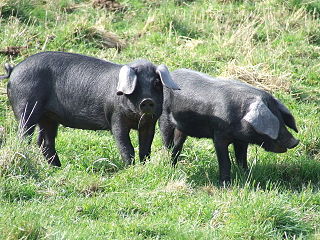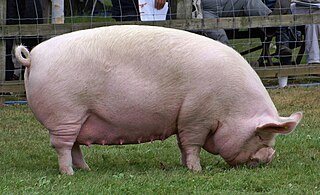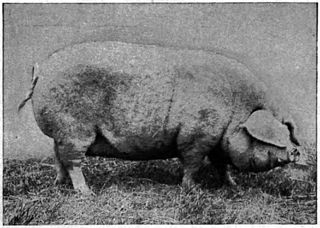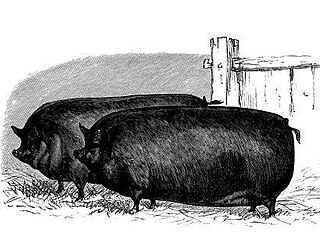Related Research Articles

The Gloucestershire Old Spots is an English breed of pig which is predominantly white with black spots. It is named after the county of Gloucestershire. The Gloucestershire Old Spots pig is known for its docility, intelligence, and prolificity. Boars reach a mature weight of 600 lb (272 kg) and sows 500 lb (227 kg). The pigs are white with clearly defined black spots. There must be at least one spot on the body to be accepted in the registry. The breed's maternal skills enable it to raise large litters of piglets on pasture. Its disposition and self‑sufficiency should make it attractive for farmers raising pasture pigs and those who want to add pigs to diversified operations.

The Tamworth, also known as Sandy Back and Tam, is a breed of domestic pig originating in its namesake Tamworth, Staffordshire United Kingdom, with input from Irish pigs. It is among the oldest of pig breeds, but as with many older breeds of livestock, it is not well suited to modern production methods and is listed as "Threatened" in the United States and "Vulnerable" in the UK by the Rare Breeds Survival Trust, as fewer than 300 registered breeding females remain. This animal is of ginger to red colouration and is thought to have descended from wild boars, via native pig stock of Europe. Principal populations today are in the United Kingdom, Australia, the United States, New Zealand, and Canada.

The Angeln Saddleback, also known as the Angler Sattelschwein, is a rare breed of domestic pig grown mainly in Schleswig-Holstein, Germany. It is a large, lop-eared, black pig with a white belt around its body at the forefeet.

The Bentheim Black Pied, also known as Schwarz-Wesses or Buntes Bentheimer Schwein, is a rare breed of domestic pig in Germany.

The Essex is a breed of domestic pig originating in the United Kingdom.

The Berkshire is a British breed of pig. It originated in the English county of Berkshire, for which it is named. It is normally black, with some white on the snout, on the lower legs, and on the tip of the tail.

The Shetland Islands of Scotland have long had their own distinct animal breeds, due to the remoteness of the archipelago. Below is a list of Shetland's domesticated animals.

The Wessex Saddleback or Wessex Pig is a breed of domestic pig originating in the West Country of England, (Wessex), especially in Wiltshire and the New Forest area of Hampshire. It is black, with white forequarters. In Britain it was amalgamated with the Essex pig to form the British Saddleback, and it is extinct as a separate breed in Britain. However, the Wessex Saddleback survives in Australia and New Zealand.

The Large Black pig is a British breed of domestic pig. It is the only British pig that is entirely black. It was created in the last years of the nineteenth century by merging the black pig populations of Devon and Cornwall in the south-west with those of Essex, Suffolk and Kent in the south-east. It is hardy, docile and prolific; it forages well and is suitable for extensive farming, but not well suited to intensive management.

The Mangalica is a Hungarian breed of domestic pig. It was developed in the mid-19th century by crossbreeding Hungarian breeds from Nagyszalonta and Bakony with the European wild boar and the Serbian Šumadija breed. The Mangalica pig grows a thick, curly coat of hair. The only other pig breed noted for having a long coat is the extinct Lincolnshire Curly Coat pig of England.

The Middle White is a breed of domestic pig native to the United Kingdom. It originated in Yorkshire roughly around the same time as the Large White. Its name comes from the fact that it was between the size of the Large White and the now-extinct Small White. It was fully recognized as a breed in 1884. The breed is known as a pork producer, and is best known for its sharply upturned snub nose. It is docile and often kept outdoors in grazing situations. Though its numbers have rebounded somewhat, the breed is listed as endangered by the Rare Breeds Survival Trust.

The Welsh is a breed of domestic pig native to Wales. It is a large white breed known for its hardiness in outdoor (extensive) farming, its long, pear-shaped body and its lop-ears. The breed was first mentioned in the 1870s, and after the Howitt committee report in 1955, became the third most common sire in the United Kingdom after the Large White pig and British Landrace pig. The Welsh pig experienced a decline in numbers in the late twentieth century because consumer demands had changed and the carcase was considered too fatty. In 2005 the breed was considered endangered and later came under the auspices of the Rare Breeds Survival Trust. Since then numbers have expanded somewhat, and by 2012, the registered breeding herd had increased to over 1000 animals.

The Guinea hog, officially namedAmerican Guinea Hog, also called the pineywoods Guinea, Guinea forest hog, acorn eater, and yard pig, is a breed of domestic pig originating in the United States. Despite its name, the breed is not from the country of Guinea, though the foundation stock was thought to be derived from West Africa. Newer DNA studies point to European origin. It's believed the American Guinea Hog is related to the Improved Essex, a now extinct breed. The Guinea hog is a rare breed with a black coat, sturdy body, curly tail and upright ears.
The Dorset Gold Tip was a breed of pig originating in the United Kingdom. It is now considered extinct.

The Lincolnshire Curly Coat or Lincolnshire Curly-coated, also known as the Baston Pig, is an extinct British breed of domestic pig. It originated in, and was named for, the county of Lincolnshire, in the East Midlands. Like many other traditional pig breeds, it became rare after the Second World War. By 1970, it had disappeared. An older, still existing breed of similar looking pigs is the Hungarian Mangalica.

The Small White or Small Yorkshire was a British breed of domestic pig, common during the nineteenth century. It is now extinct, but its characteristics were used in producing the Middle White and other breeds.
The Cumberland was a breed of domestic pig that originated in the North of England; it was used to produce local delicacies like the Cumberland sausage and Cumberland ham. The breed became extinct in 1960, after changes in farming methods and a demand for less fatty meat led to it falling out of favour.

The Small Black or Suffolk pig was a breed of domestic pig originating in the United Kingdom during the nineteenth century. It is now extinct.

The British Landrace is a British domestic breed of pig and one of the most popular in the United Kingdom. It is white with heavy drooping ears that cover most of the face and is bred for pork and bacon. The breed originated in the 1949 importation of 12 landrace pigs from Scandinavia — four boars and eight gilts. In 1950, the British Landrace Pig Society was formed and it opened a herd book for the first offspring born from the imported 12. They created the first pig testing scheme with a testing station at the village of Stockton-on-the-Forest in North Yorkshire.
The Large White Ulster, or Ulster White, was a breed of domestic pig. Primarily bred for bacon production, it was the favoured breed of farmers in the north of Ireland up until the mid 20th century.
References
- 1 2 Porter, V. Pigs: a handbook to the breeds of the world, Comstock, 1993, p.107
- 1 2 Hartley and Ingilby (1972). Life in the moorlands of North-East Yorkshire. J M Dent. p.28
- ↑ The Decline of Traditional Breeds Archived February 27, 2012, at the Wayback Machine , British Pig Association
- ↑ Bilsdale Study Group Newsletter, 8 Oct 2013, 2